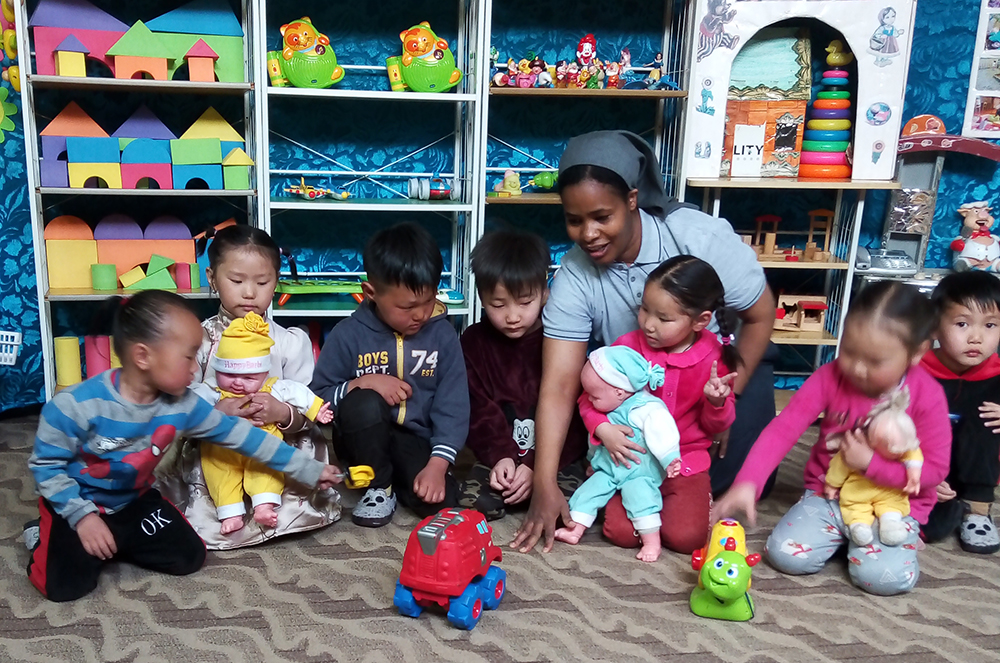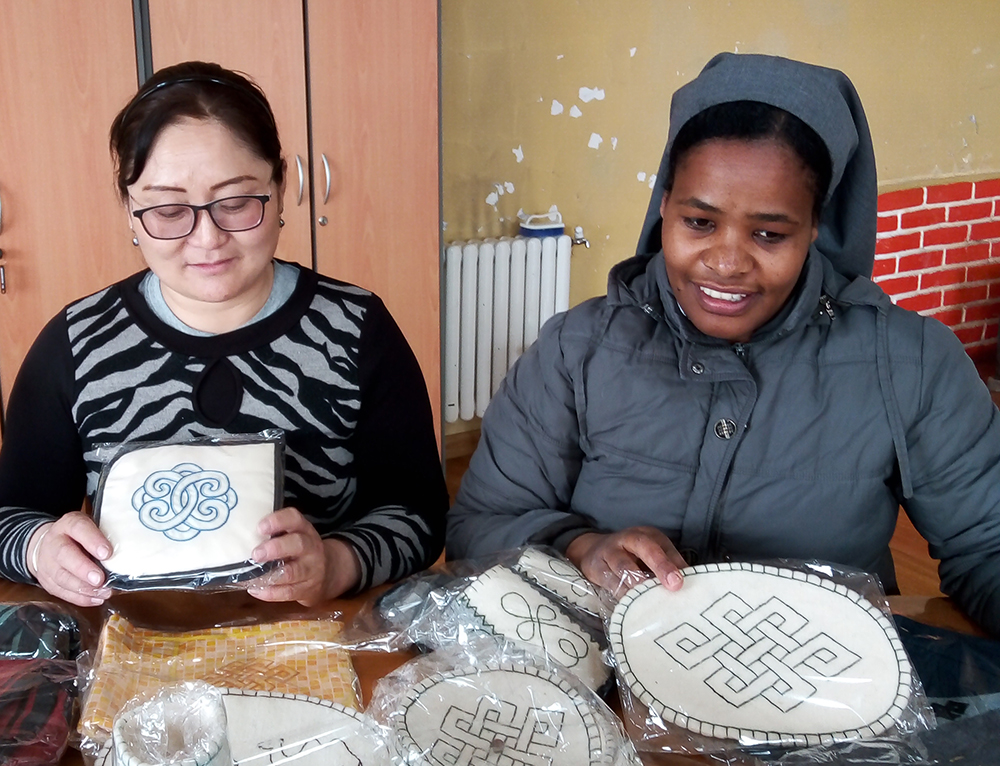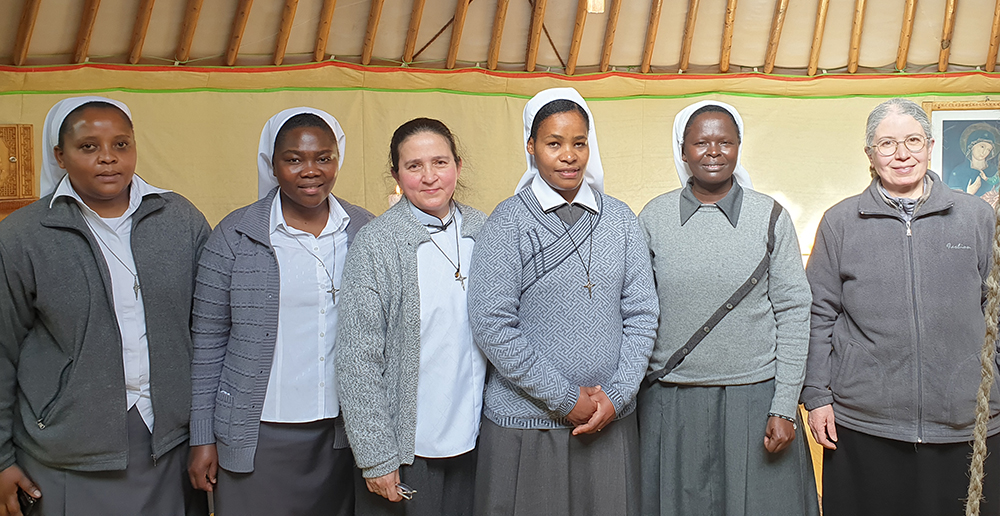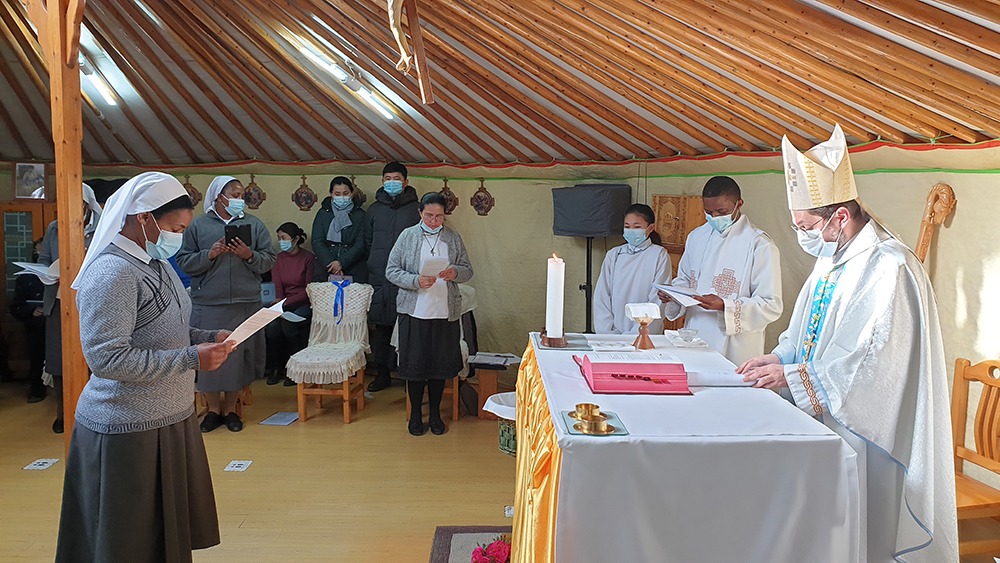
Sr. Tireza Gabriel Usamo plays with children at a day care center run by Consolata Missionaries. (Courtesy of Tireza Gabriel Usamo)
Editor's note: This Q&A was previously published at UCA News. It has been edited and condensed to fit Global Sisters Report's style.
For Sr. Tireza Gabriel Usamo, a 38-year-old Catholic nun from Ethiopia, the climate and customs of Mongolia have been a constant challenge since she arrived there as a missionary. She is part of a three-member team of nuns from Consolata Missionaries working in Arvaikheer in central Mongolia.
The church in Mongolia was re-established when three Immaculate Heart of Mary missionaries arrived there in 1992, a year after democracy was restored after the fall of communism. The Catholic Church was active in Mongolia in the 13th century, but its role was ended by the Yuan Dynasty in 1368. Christianity was then forbidden in a country sandwiched between China and Russia.
As the church marks 30 years of its reincarnation in 2022, it has two Mongol priests, 22 foreign missionaries and about 35 missionary nuns, including Usamo. They work for some 1,400 Catholics under the Ulaanbaatar Apostolic Prefecture, which covers the entire country of some 3.3 million people.
In an interview with UCA News editor Rock Ronald Rozario, Usamo discussed the tiny church in Mongolia, its culture and diverse customs, and the challenges missionaries face there.
UCAN: What do Consolata nuns focus on in the Mongolian mission?
Usamo: Our sisters work to be close to people through social activities such as working with children and women. We started working here about two decades ago. We now serve in the capital, Ulaanbaatar, and Arvaikheer, focusing on people.
For example, in Ulaanbaatar, we run a center for children. It has facilities for them to play, stay and do homework after school. In Arvaikheer, we run a sewing center for 16 women where they make handbags and do embroidery work.
The sewing center aims to make women self-reliant. We buy their handmade products and pay them. But we do not do it as a business to make money. Therefore, we do not sell their products in the market but give them as gifts to various countries and visitors. These are poor women, and their income is good support for their families.
We also run a kindergarten. The small children come for education, and they can also stay there for free. They are mostly children of workers.
We also run a free shower facility. Mongolia has an acute water scarcity. Its rivers and groundwater are reported to be polluted because of industrialization and mining activities. So, some five years ago, we started a facility offering people a shower in all seasons.
The free shower is part of our mission to be close to the people and stay together. These are small acts of generosity that can touch their hearts. This gives them the sense that we are living among them and love them whether they are Christian or not.
We also visit their families from time to time. If they are poor, we help them by providing food. For example, when we have a feast, we visit them with gifts. Our bishop informs us whenever there is a need, and we lend our helping hand.

Consolata Missionary Sr. Tireza Gabriel Usamo, right, at a church-run handicrafts center for women in Arvaikheer, Mongolia (Courtesy of Tireza Gabriel Usamo)
How different is life in Ethiopia from Mongolia?
Social life is very different in Mongolia than in my country. For example, people here live in one ger [traditional Mongolian tent]. One family has one ger, which is a large room, and live together. It is unthinkable in Ethiopia.
A typical Mongolian ger is a round tent made of wood lattice and heavy felt sheet. Thanks to the excellent insulating of the felt sheets, a ger remains quite warm during winter and comfortable during summer. Usually, a ger is separated by two sides — left and right or east and west. Male members stay on one side and females on the other side. They have a toilet outside.
In the countryside, a ger has everything for a family. In the middle, they install a wood-fired or gas stove, which is used for both cooking and heating. They cook everything in one pan together — meat, potato, carrot and sometimes rice with meat. They use very little water for washing dishes and clothes. Family members have very few clothes except for winter clothes.
Mongolians in urban areas have a regular life like people in cities in other parts of the world. But those in the countryside are still nomads. They travel from one place to another. When they leave one place, they carry the materials of their ger and set up a new one in the new place. Most Mongolians in the countryside depend on rearing animals like cows, goats, sheep and yaks. So, they usually install a ger where they can find grazing fields for their livestock.
Their way of welcoming guests is interesting. In Ethiopia, we offer tea or coffee to people. Here, they offer milk mixed with a bit of salt. I enjoy this whenever I visit people in their houses. They mostly offer cold cow milk in a traditional cup, holding it with two hands. Their offer of milk to visitors means they consider the person as one of them.
If the guest is an important person, they offer him or her a traditional Mongolian hadag [sacred blue scarf] on the first visit. That is the highest form of well-wishing and greeting in Mongolia. A hadag is made of silk and should always be blue, as blue is considered the most sacred color in Mongolian culture. It represents the blue sky.
Advertisement
How hard is the mission in Mongolia?
In a large country with just 3.2 million people and a harsh continental climate, it surely is not an easy one. I was told it is a very cold country when I was preparing for this mission. But when I arrived, it was beyond my expectations. It is extremely cold. I have experienced cold that was minus 39 or 40 degrees in the past four years.
Dressing in winter clothes was challenging for me. It was difficult for me to wear such dress and continue working. Indeed, it is very tough to work here during the winter. When I look through the window, I can only see white snow, and outside is extremely cold. As I was not able to endure the cold, I thought I couldn't survive. Then I learned how to dress and started going out. I also joined a class to learn the Mongolian language.
Mongolians are habituated to extremely cold winters. They worry if the winter is not cold enough or snowing is less. They fear less cold would have a bad impact on the health of humans and animals and there might be an outbreak of diseases. During winter, they stock up on firewood and charcoal to make fire and to keep the ger warm.
Farming is possible only in some parts of Mongolia. In most places, just like in Arvaikheer, people are mostly shepherds who rear cows, goats, sheep and yaks for a living. Animal husbandry is an integral part of the traditional, rural Mongolian lifestyle.
I have slowly started to enjoy the nature here and how four seasons change one after another. I appreciate the beauty of God's creation. It also provides an opportunity to obtain wisdom. There is a cold season when everything seems dead and then comes the hot summer season, when there is life and greenery. It is like the unending circle of life — dry winter and lively summer. I realized that God created every place differently, and we need to have eyes to discover the beauty. In Mongolia, I see the God-gifted beauty in nature and people.

Sr. Tireza Gabriel Usamo with other Consolata Missionaries after her final vows in January (Courtesy of Tireza Gabriel Usamo)
What are other challenging factors in the Buddhist-majority country?
Mongolia has only some 1,400 Catholics, but they are very welcoming and are strong in faith. Some non-Christians see us and try to follow us.
Mongolians have their rituals and cultural heritage, which are quite strong. Many Mongolians, whether they follow a religion or not, go to the mountains early in the morning to pray and talk to the spirits. There are also some specific rituals for Buddhists and shamanic followers.
Some cultural practices are tangible. For example, when the first sun of the Lunar New Year appears, they all go to the mountains. Even Christians who come to Mass also go to the mountains. In some way, they consider it part of the Christian faith. In the Bible, we have the prophets and Jesus, who went to the mountains to pray and to be closer with God.
We must know their language to understand their culture. It is not easy to change their hearts. Even Catholics continue to follow their old traditions because they grew up in that tradition. On certain days, they go to the mountains before coming to Mass in the morning. We cannot tell them not to go. We must accept it and give it an interpretation based on the Christian faith.
What are your suggestions for the expansion of the church in the country?
Catholicism in Mongolia has a long history, beginning in the 13th century. But the number of Catholics was very small during that period. Then successive regimes prohibited Christianity until Mongolia became a democratic nation in 1992.
The Catholic mission was restarted here in 1991, and this year, we are celebrating the 30th year of the return of Catholic missionaries after diplomatic relations between the Vatican and Mongolia were established. In the past 30 years, many interesting things have happened. We have 1,400 baptized Catholics in Mongolia in eight parishes. Every year during Easter, some new members are baptized. In our parish in Arvaikheer, one family was baptized this Easter. So, there is hope and light for missionaries like me. It takes time for the church to grow. The church cannot expand overnight. We are progressing slowly. Day after day, year after year, the church grows step by step.

Sr. Tireza Gabriel Usamo professes her final vows as a member of Consolata Missionary congregation on Jan. 29. (Courtesy of Tireza Gabriel Usamo)
How is your missionary experience shaping your own faith and life?
I knew nothing about the country when I came here. I attended programs and participated in Mass, but I mostly kept silent. I looked at people, smiled and tried to understand local life, but in silence. I felt like a baby learning to walk and talk. It helped me to enter my inner self, to listen to myself. In my country, I was a teacher, but here I am learning to be present among the masses. Slowly, I started to learn everything — to eat the local food and to greet and talk. I learned the language, and it helped me to get close to the people. I realized it was my invitation for personal growth.
From time to time, I keep silence and think about my vocation, why Jesus has called me here and what is my contribution? It took time for me to learn, and I faced many challenges. I have overcome challenges with my conviction and sharing with others in the community about my difficulties. Sometimes I feel tired, but I overcome it by listening and sharing with others. Life is a gift from God, but it needs my contributions to build up through different experiences. This is how transformation takes place. Now, I enjoy my life here and I feel Mongolia is like my home.
What are your future plans?
As a young missionary nun in Mongolia, I had my final vows on Jan. 29. I thank God for calling me to be his missionary. My future is in God's hands, not mine. I will keep doing with sincerity what I have been asked to do here. I will go to and work in any place wherever my superior wants me to work. I have faith in God, and I am determined to do anything for the glory of God. I am ready to sacrifice my life for the special mission God has given me.






